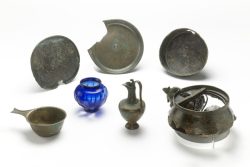 BRITISH Museum curator Sophia Adams will give a talk about the important Iron Age and Roman finds from a grave on Cranborne Chase, at the Dorset Museum in Dorchester on Thursday 18th April at 7pm.
BRITISH Museum curator Sophia Adams will give a talk about the important Iron Age and Roman finds from a grave on Cranborne Chase, at the Dorset Museum in Dorchester on Thursday 18th April at 7pm.
“Traditions and Transitions: The Story of the Chettle Grave Group” will discuss the 2003 discovery of a locally made bronze mirror and strainer bowl, an imported bright blue glass jar and several Roman vessels that were buried in the late first or early second century AD.
The objects had been carefully arranged in a cluster with the shallow dishes set up on their edges resting against the strainer bowl. Beside these was a large, round-bodied glass bottle of a type usually found with cremated remains of a person.
The Iron Age mirror was the oldest item buried in the grave, probably older than the deceased person. The complex design on the mirror is similar to that of the Portesham Mirror which is displayed at Dorset Museum & Art Gallery.
The strainer bowl is particularly exciting because only a handful are known and are rarely complete. The only example known outside southern England was found in Poland.
The two glass vessels are among the newest objects in the grave and set the earliest possible date for burial to more than 25 years after the Roman conquest – possibly as early as 70AD or as late as 125AD.
Following conservation work, the Chettle group is now displayed in the Britain and Europe gallery at The British Museum. Sophia Adams is responsible for collections from the first millennium BC in Europe and the Roman conquest of Britain. Her lecture will guide attendees through a close-up look at these fascinating finds.
Pictured is part of the Chettle Grave Group ready for display © Trustees of the British Museum